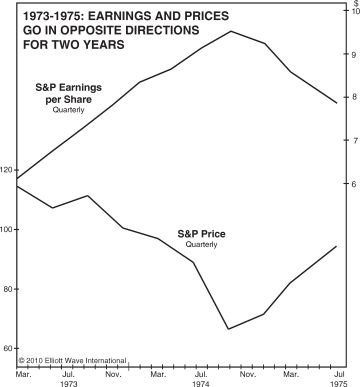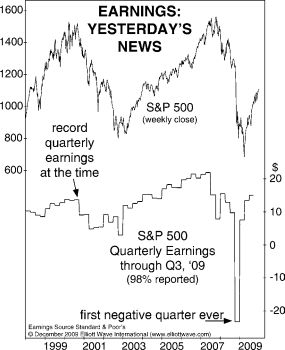Here’s What You Need to Know About Earnings Season
Investing based on earnings “is akin to driving down the highway looking only in the rearview mirror”
Many investors and financial journalists believe that corporate earnings play a substantial role in driving stock market prices.
This headline from a few months ago captures the traditional thinking (Business Insider, April):
Stocks are poised for a big 2024 as corporate earnings stay strong … [major bank] says
The idea that earnings drive stock market prices seems to make sense. After all, corporations exist to make money, and if they exceed expectations, it seems logical that their share prices should skyrocket. If earnings disappoint, logic suggests that stocks should tank. And, in all fairness, when it comes to individual companies’ earnings, they can and do affect prices — although not always, and not always logically. But when you compare broad market performance with trends in earnings, you start to see a glaring disconnect. Why?
Because investors are not governed by pure logic. They are governed by collective psychology — which swings from optimism to pessimism and back again, regardless of factors like GDP numbers, unemployment or — yes, earnings.
Let’s make the point by using a historical example from Robert Prechter’s must-read book, The Socionomic Theory of Finance. Here’s a chart and commentary:

… in 1973-1974, earnings per share for S&P 500 companies soared for six quarters in a row, during which time the S&P suffered its largest decline since 1937-1942. This is not a small departure from the expected relationship; it is a history-making departure. … Moreover, the S&P bottomed in early October 1974, and earnings per share then turned down for twelve straight months, just as the S&P turned up!
A more recent historical example is from the December 2009 Elliott Wave Financial Forecast, a publication which covers major U.S. financial markets.

… quarterly earnings reports announce a company’s achievements from the previous quarter. Trying to predict future stock price movements based on what happened three months ago is akin to driving down the highway looking only in the rearview mirror.
You’ll notice on the chart that in Q4 2008, the S&P 500 had its first negative earnings quarter ever. According to conventional logic, stocks should have crashed afterwards.
Instead, a rally started in March 2009, which stretched all the way into early 2022.
If earnings and other factors outside of the market do not determine the trend of stock market prices, what does?
The answer is the Elliott wave model.
If you’d like to learn about Elliott wave analysis, read Frost & Prechter’s book, Elliott Wave Principle: Key to Market Behavior. Here’s a quote:
Without Elliott, there appear to be an infinite number of possibilities for market action. What the Wave Principle provides is a means of first limiting the possibilities and then ordering the relative probabilities of possible future market paths. Elliott’s highly specific rules reduce the number of valid alternatives to minimum.
If you’d like to find out about “Elliott’s highly specific rules,” you can do so by reading the online version of Elliott Wave Principle: Key to Market Behavior for free.
All that’s required for free access to this Wall Street classic is a free Club EWI membership. Also know that Club EWI members enjoy free access to a wealth of Elliott wave educational resources without any obligations.
Join the approximately 500,000 Club EWI members who are already gaining insights into trading and investing from an Elliott wave perspective by following this link: Elliott Wave Principle: Key to Market Behavior(get free access now).